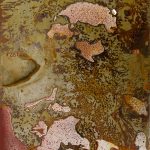Endel Maas
- Faculty of Design
- Jewellery and Blacksmithing
- ba
- Memory death
- Tutor(s): Urmas Lüüs, Nils Hint
- etching with acid, plasmacutting, patination
- 30x 42cm
Memory is one of the most important aspects about life. Memory lets you learn skills and learn from the past. It helps organize the past into a coherent set of data that helps us make decisions and choose the best probable outcome. There are several types of memory. Alongside our individual memories there is also the collective memory, how we remember events as a society. The entire world runs on memory, without it culture can not exist, nor can society, or individuals. Our memory makes us who we are. Memory can not exist without memory carriers, whether it is the humans who remember or a physical object like a photo or a flash drive. A human truly dies only when the last memory of him is forgotten.
My thesis work tells a tale of the degradation and fading of memory. Being human is knowing that one day you will inevitably fade away, first from life and then from memory. It is something very personal yet very human in its repeating pattern. The tale of my work begins with a photo that was found next to a rotting carcass of a house. The somewhat damaged picture depicts a middle aged woman celebrating an event of obvious importance, looking at the camera with a mysterious tension on her face. But what truly intrigued me was the remains of another picture that had partially transferred to the backside of the photo. Even though incredibly damaged, the image appears to depict a man. As if fighting off the inevitable oblivion, trying to fend off nothingness and attempting to still remain as memory as long as possible. Even if the only way to achieve that is as a faded shadow on the back of another damaged and lost memory carrier. In my thesis work i decided to focus on that man. I will give him that one last moment of memory, so that perhaps he can finally accept the inevitable fading out of memory that is to come.
As the material for my work i have decided to use iron, i chose it because of its ease of oxidation and because just like with memory, it will never stop oxidizing. The techniques i chose for my work are etching and patination. I find that both have parallels with the degenerative properties of memory. Some brighter fragments of memory remain longer than others, just like brief flashes of light in an ocean of nothingness, while all others slowly corrode away. All together the project consists of 10 sheets of steel, with the image of the man on the back of the picture etched into them. The individual sheets show the different ways how the memories can fade. Memory degradation is not uniform, it is quite dependent on random circumstances and events. Both the important and the mundane are forgotten equally, sooner or later all is forgotten.









